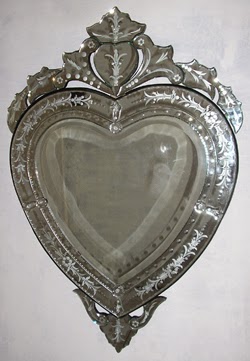
special mirror caravan spiegels __ Venetian glass production dates back to 982, with a document that makes reference to a bottle maker called Dominicus Phiolarius (from it. fiole: bottles). In 1090 a Petrus Flabianicus was also mentioned. But already in 450, in the Venetian lagoon and in the surroundings there were glass-workers that produced the tesseras for the mosaics of the local churches. However, no Venetian glass preceding the XVth century has arrived to us, while the glass of the Islamic art arrived to Venice from Constantinopole after the IVth Crusade (1204), is kept in the Treasure of St. Mark.
The development of Venetian glass factories was quick: in 1271 a first “capitulary” was introduced to regulate the art of glass making. The importation of foreign glass into Venice was forbidden and foreign glass makers were prevented from working in the city. The Guild of glass makers was under the authority and protection of the Republic, and their formulas were highly valued and kept strictly secret. These “partite” or recipes, were handed down from father to son and transcribed into secret books. In fact these secret techniques were of such great importance as to make the difference between the glass produced in Venice and that of other European glass centres.
In 1291 in order to counter the risk of fire, all of the furnaces of Venice were moved to the island of Murano, where the art of glass has been kept alive (till today). In 1295 another strict "capitulary" was issued: in it the emigration of Venetian glass makers abroad was forbidden.
The continuous development of glass industry and art in Murano required a modification of the statutes of 1271 which led up to the “Mariegola dell’arte dei verieri da Muran”, in 1441. Venice got an indirect knowledge of “enamelled” glass of Syrian origins that influenced enormously the creation of those goblets and stem glasses with enamel decoration that date back to the XIVth and XVth century, like Aldrevandin’s glass and the one kept in Switzerland in the Cathedral of Coira.
The decoration of Venetian glass was also influenced by the craftsmen arrived from the Middle East, after the Fall of Damascus in 1400 and of Constantinopoles in 1435, which closed definively the history of the Roman Empire.Towards the half of the XVth century, above all because of these external influences, the production of glass with dark colours decorated and painted with bright coloured enamel was successful.
At the mid of the XVth century, a perfect clear, flawless glass was produced by Angelo Barovier which became called “vetro cristallo” or "cristallo veneziano". The chemical composition of this kind of glass allowed complex and long works typical of the Murano tradition. The Venetian factories that made goblets, glasses, dishes, bowls etc., exported their objects all around Europe, where the elegance and lightness of this material was appreciated.
Venice kept protecting the secret of the production of glass and of crystal but, notwithstanding it, the Republic partially lost its monopoly at the end of the XVIth century, because of some glass makers (e.g. Verzelini) who let the secret be known in many European countries. Venice reacted to this competition producing more and more original objects, with fancier and more exuberant decorations: glasses and goblets with handles and decorated by figures of animals, “acquerecce” and “versatoi” (jugs and ewers) ship-shaped, entirely made of glass, fruit-stands supported and decorated by serpents, dragons, sea-horses, dolphins.
In the XVIth century the quest for new materials led to the realization of an opaque white glass called "lattimo" (from it. latte: milk). Subsequently the "filigree" and the "retorti" glass were created; in 1527 Filippo Catani patented the "zanfirico" (or "retorti") filigree with milky canes included in cristal and twisted as spiral. Those techniques represent a simbol of the classic Murano glass till today.
Towards the end of the XVIIth century and in the XVIIIth, the production of mirrors imposed itself: mirrors were all pretty small, because they were made out of sheets of blown glass, unlike those of other countries which were melted in big surfaces and then polished. These mirrors were decorated with cut figures or enriched by big glass frames or with coloured glass applications.
In the XVIIIth century there was the rise of Giuseppe Briati’s industry: he created the a ciocche chandelier. As consequence of the political collapse with the fall of the Republic, the economic crisis and the foreign dominations, between the end of the XVIIIth century and the mid of XIXth didn’t produce anything new in the artistic field, and the glass factories were content with the production of beads for necklaces and rosaries.
It is in 1840 Pietro Bigaglia breathed new life into the art glass production, also creating the innovating millefiori paperweight. With the end of the XIXth century, Murano re-started pratice of art glass, reviving the tecniques of its past. During this part of the century was born a new generation of master glassmakers focused to re-lerning the manual and technical skills which until just a few years before might seemed lost.
In the following century some glass factories led by craftsmen or industrialists like Venini, Barovier, Salviati, Toso, Cenedese, Barbini (and many others)., abandoned the repetitive production, which used to copy the shapes of the past, to create a big variety of artistic glass upon new designs, thanks to innovative contemporary artists.
Çontact
Us
Address :
Jln. Bonang 3 RT 2 RW 2, Joyotakan, Serengan, Surakarta, Jawa Tengah,
Indonesia, Indonesia 57157Owner : Prima Warsa BaruPhone : +62
888 6 827 827Email : sales@jagomerahcraft.comFanpage Facebook :
jagomerahcraft
Tidak ada komentar:
Posting Komentar